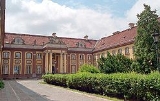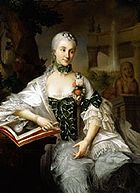
Branicki's Palace
Encyclopedia
The Branicki Palace is an 18th-century magnate
's mansion
in Warsaw
, Poland
. It is located at the junction of Podwale and Miodowa
Streets.
(the others are located on Nowy Świat Street
and Na Skarpie Avenue).
 The original building that stood where the palace now stands was a 17th century mansion
The original building that stood where the palace now stands was a 17th century mansion
of the Sapieha
family sold in the beginning of the 18th century to Stefan Mikołaj Branicki. This led to the current palace, built in 1740 by Johann Sigmund Deybel for Grand Crown Hetman
Jan Klemens Branicki
. In the construction also participated Jan Henryk Klemm (1743), Jakub Fontana (1750) and sculptor Jan Chryzostom Redler. The now rococo
palace was inspired by French palaces. The layout was shaped like a horseshoe, with a central part corps de logis
and two side wings. The building was set back from the street by a cour d'honneur
, a symmetrical courtyard set apart in this way, at which the honored visitor arrives. The façades were equalize with admirable rococo decoration and rooftop windows. Main entrance was decorated with a portico of four columns and sculptures on the top. The interiors were decorated in the rococo style by Johann Sigmund Deybel and Jakub Fontana. Later, a pavilion called "Buduar" was added to the south wing at the back.
The Branicki Palace previously had been called the Mrs Krakowska Palace, because after Branicki's death the property was succeeded to his beautiful wife Izabella Poniatowska
(1771), sister of king Stanisław August Poniatowski (Izabella was a daughter of Stanisław Poniatowski, Castellan
of Kraków
). She held a salon
in the palace, and became known as a patron and gatherer of artists, intellectuals, and statesmen in the era of Enlightenment in Poland
.
Shortly afterwards the Branicki Palace was sold in 1804 to the general Józef Niemojewski. The new owner improved the palace - the two sides outbuildings were added to the palace complex in 1804-1808 by architect Fryderyk Albert Lessel. From 1817 the palace was inhabited by the Stanisław Sołtyk.
During the Second World War, the estate was badly damaged (it was burned down in 1939 and demolished by the Germans during the Occupation of Poland), but after the war it was completely restored. It was rebuilt in 1967, based on paintings by Bernardo Bellotto
, and now houses Warsaw City Hall.
Magnate
Magnate, from the Late Latin magnas, a great man, itself from Latin magnus 'great', designates a noble or other man in a high social position, by birth, wealth or other qualities...
's mansion
Mansion
A mansion is a very large dwelling house. U.S. real estate brokers define a mansion as a dwelling of over . A traditional European mansion was defined as a house which contained a ballroom and tens of bedrooms...
in Warsaw
Warsaw
Warsaw is the capital and largest city of Poland. It is located on the Vistula River, roughly from the Baltic Sea and from the Carpathian Mountains. Its population in 2010 was estimated at 1,716,855 residents with a greater metropolitan area of 2,631,902 residents, making Warsaw the 10th most...
, Poland
Poland
Poland , officially the Republic of Poland , is a country in Central Europe bordered by Germany to the west; the Czech Republic and Slovakia to the south; Ukraine, Belarus and Lithuania to the east; and the Baltic Sea and Kaliningrad Oblast, a Russian exclave, to the north...
. It is located at the junction of Podwale and Miodowa
Miodowa
Miodowa is a street in Warsaw's Old Town. More precisely, it links the Freta Street in the New Town, with the Krasiński Square. It is also a street in the Kazimierz district in Kraków.-History:...
Streets.
History
The Palace is one of three with the same name in Warsaw. This particular Branicki Palace is on Miodowa StreetMiodowa
Miodowa is a street in Warsaw's Old Town. More precisely, it links the Freta Street in the New Town, with the Krasiński Square. It is also a street in the Kazimierz district in Kraków.-History:...
(the others are located on Nowy Świat Street
Nowy Swiat Street
Ulica Nowy Świat is one of the main historic thoroughfares of Warsaw.It comprises part of the Royal Route that runs from Warsaw's Royal Castle and Old Town, south to King Jan III Sobieski's 17th-century royal residence at Wilanów....
and Na Skarpie Avenue).

Mansion
A mansion is a very large dwelling house. U.S. real estate brokers define a mansion as a dwelling of over . A traditional European mansion was defined as a house which contained a ballroom and tens of bedrooms...
of the Sapieha
Sapieha
The Sapieha is a Polish-Lithuanian princely family descending from the medieval boyars of Smolensk. The family acquired great influence in the sixteenth century.-History:...
family sold in the beginning of the 18th century to Stefan Mikołaj Branicki. This led to the current palace, built in 1740 by Johann Sigmund Deybel for Grand Crown Hetman
Hetman
Hetman was the title of the second-highest military commander in 15th- to 18th-century Poland and the Grand Duchy of Lithuania, which together, from 1569 to 1795, comprised the Polish-Lithuanian Commonwealth, or Rzeczpospolita....
Jan Klemens Branicki
Jan Klemens Branicki
Count Jan Klemens Branicki was a Polish nobleman, magnate and Hetman, Field Crown Hetman of the Polish-Lithuanian Commonwealth between 1735 and 1752, and Great Crown Hetman between 1752 and 1771....
. In the construction also participated Jan Henryk Klemm (1743), Jakub Fontana (1750) and sculptor Jan Chryzostom Redler. The now rococo
Rococo
Rococo , also referred to as "Late Baroque", is an 18th-century style which developed as Baroque artists gave up their symmetry and became increasingly ornate, florid, and playful...
palace was inspired by French palaces. The layout was shaped like a horseshoe, with a central part corps de logis
Corps de logis
Corps de logis is the architectural term which refers to the principal block of a large, usually classical, mansion or palace. It contains the principal rooms, state apartments and an entry. The grandest and finest rooms are often on the first floor above the ground level: this floor is the...
and two side wings. The building was set back from the street by a cour d'honneur
Cour d'Honneur
Cour d'Honneur is the architectural term for defining a three-sided courtyard, created when the main central block, or corps de logis, is flanked by symmetrical advancing secondary wings, containing minor rooms...
, a symmetrical courtyard set apart in this way, at which the honored visitor arrives. The façades were equalize with admirable rococo decoration and rooftop windows. Main entrance was decorated with a portico of four columns and sculptures on the top. The interiors were decorated in the rococo style by Johann Sigmund Deybel and Jakub Fontana. Later, a pavilion called "Buduar" was added to the south wing at the back.
The Branicki Palace previously had been called the Mrs Krakowska Palace, because after Branicki's death the property was succeeded to his beautiful wife Izabella Poniatowska
Izabella Poniatowska
Countess Izabela Poniatowska was a Polish noblewoman . She was a sister of Stanisław Antoni Poniatowski, who in 1764 became King of Poland and Grand Duke of Lithuania, and reigned as Stanisław II August....
(1771), sister of king Stanisław August Poniatowski (Izabella was a daughter of Stanisław Poniatowski, Castellan
Castellan
A castellan was the governor or captain of a castle. The word stems from the Latin Castellanus, derived from castellum "castle". Also known as a constable.-Duties:...
of Kraków
Kraków
Kraków also Krakow, or Cracow , is the second largest and one of the oldest cities in Poland. Situated on the Vistula River in the Lesser Poland region, the city dates back to the 7th century. Kraków has traditionally been one of the leading centres of Polish academic, cultural, and artistic life...
). She held a salon
Salon (gathering)
A salon is a gathering of people under the roof of an inspiring host, held partly to amuse one another and partly to refine taste and increase their knowledge of the participants through conversation. These gatherings often consciously followed Horace's definition of the aims of poetry, "either to...
in the palace, and became known as a patron and gatherer of artists, intellectuals, and statesmen in the era of Enlightenment in Poland
Enlightenment in Poland
The ideas of the Age of Enlightenment in Poland were developed later than in the Western Europe, as Polish bourgeoisie was weaker, and szlachta culture together with the Polish-Lithuanian Commonwealth political system were in deep crisis...
.
Shortly afterwards the Branicki Palace was sold in 1804 to the general Józef Niemojewski. The new owner improved the palace - the two sides outbuildings were added to the palace complex in 1804-1808 by architect Fryderyk Albert Lessel. From 1817 the palace was inhabited by the Stanisław Sołtyk.
During the Second World War, the estate was badly damaged (it was burned down in 1939 and demolished by the Germans during the Occupation of Poland), but after the war it was completely restored. It was rebuilt in 1967, based on paintings by Bernardo Bellotto
Bernardo Bellotto
Bernardo Bellotto was a Venitian urban landscape painter or vedutista, and printmaker in etching famous for his vedutes of European cities . He was the pupil and nephew of Canaletto and sometimes used the latter's illustrious name, signing himself as Bernardo Canaletto...
, and now houses Warsaw City Hall.
See also
- Branicki Palace, Białystok
- Palace under the Four WindsPalace under the Four WindsThe Palace of the Four Winds , also known as the Tepper Palace, is a baroque palace in Warsaw located at ulica Długa 38/40.-History:...
- Brühl Palace, WarsawBrühl Palace, WarsawThe Brühl Palace , otherwise known as Sandomierski Palace standing at Piłsudski Square. It was a large palace and one of the most beautiful rococo buildings in pre-World War II Warsaw.-History:...

